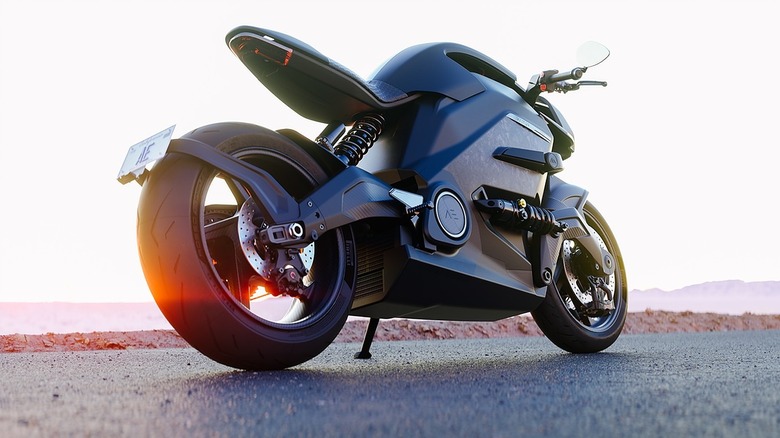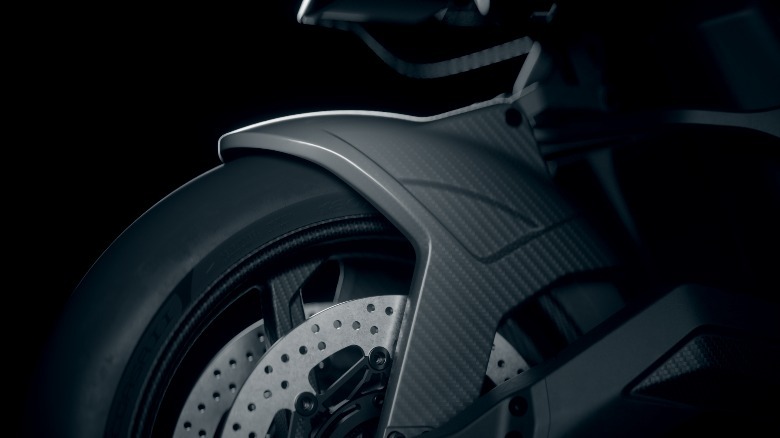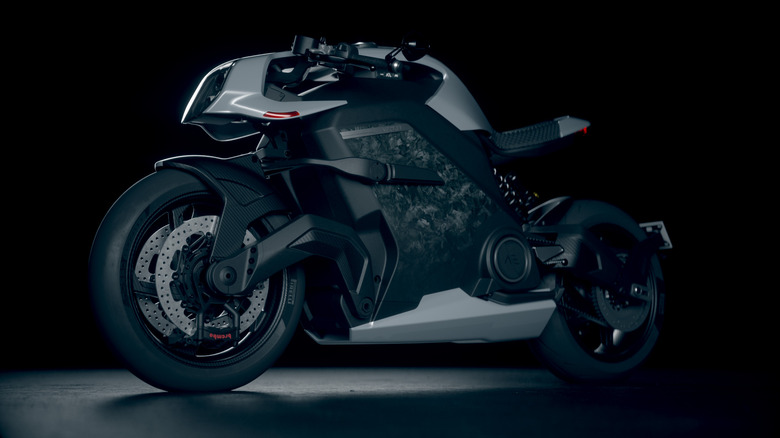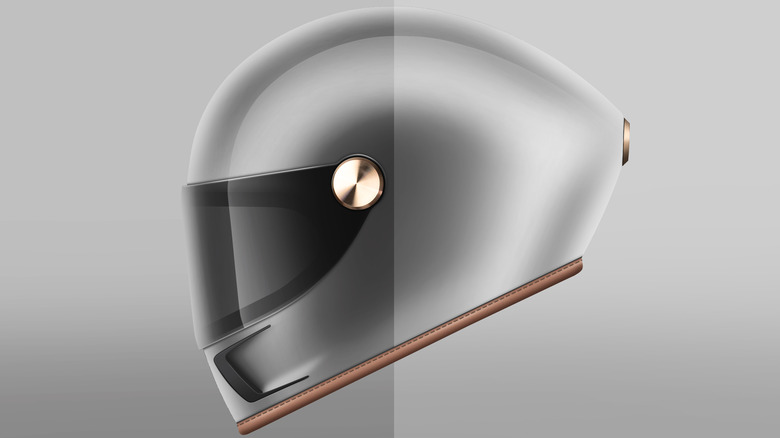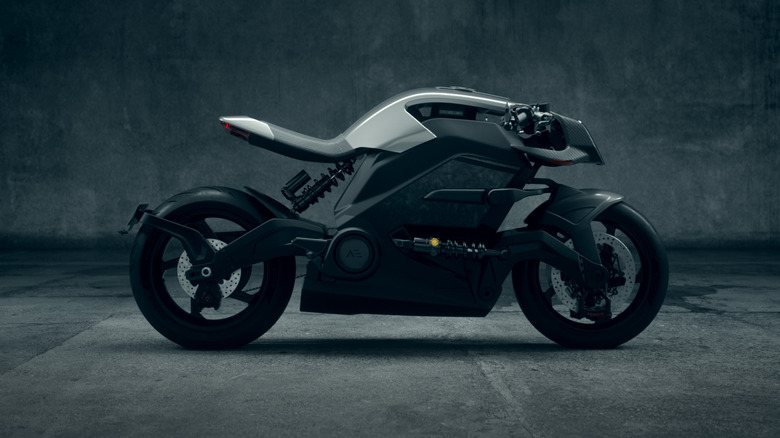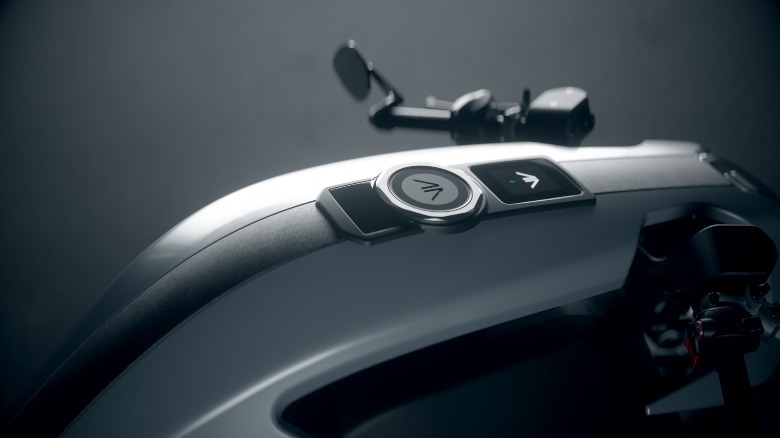This Tesla Of Electric Motorcycles Is Finally Ready For The Road
British electric motorcycle builder Arc debuted its first premium electric bike, the Vector EV, in 2018 at the Italian EICMA Motorcycle show in Milan. Arc billed it as the most premium, advanced, and individualized zero-emissions motorbike the world had ever seen, and though felel short of calling it the Tesla of electric motorcycles, that didn't stop people comparing the two-wheeler to Elon Musk's best-selling EVs. After recovering from "financial troubles" in 2019, Arc has announced it is finally ready to release the first ten, limited-edition Vector Angel Edition (AE) prototypes to ten lucky customers. Each recipient will also get to participate in a once-in-a-lifetime AE Program to develop the bike's proprietary Arc HMI System.
The Vector Angel Edition's futuristic, head-turning design certainly isn't short on exotic detailing, and — though startups with odd-looking motorcycles aren't so rare these days — it probably won't be mistaken for any other bike on the road. Most of the buzz, however, centers around what Arc calls its "breakthrough human-machine interface" or HMI, a system that enhances the riding experience by connecting the rider to the motorcycle and its environment using a hi-tech helmet and matching riding gear.
"This is an incredibly important step for motorcycling that has many layers. Initially, it's about creating a system that can heighten the enjoyment of riding motorcycles and saving motorcyclists' lives each year," Mark Truman, founder and CEO of Arc, said of the accessories. "In the future, the ability to connect to the IoT (Internet Of Things) and the integration of AR (Alternative Reality) technology into systems like this will make motorcycling far safer."
Arc Vector Angel Edition: For the lucky few
Once the ten customers receive their fully-personalized Vector Angel Edition electric motorcycles, each will undergo a testing program to have first dibs at Arc's HMI System on racetracks in the U.S. and the United Kingdom. After that, Arc will upgrade each Angel Edition with beta versions of the HMI for the ten clients to test on public roads. The most exciting part is when each of the ten customers takes delivery of the first production Vectors after final testing. "We wanted to give those involved in the AE Program the ultimate peek behind the curtain," said Truman.
Arc adds the AE program would take approximately two years after customers take delivery of their Angel Edition Vector bikes. Meanwhile, Arc will begin offering the HMI system across its motorcycle lineup in the same period, around 2024 to early 2025. It's still a long way to go, but then again developing a new vehicle for production is something which has confounded plenty of ambitious startups before now.
Zenith & Origin
The Arc HMI System comprises the Arc Zenith helmet and the Arc Origin armor-jacket. The Zenith helmet is unlike conventional brain buckets. It has Wi-Fi connectivity, voice activation, and a built-in heads-up display (HUD) that shows the speed, sat-nav, and data from the helmet's standard rearview camera. The HUD's live video feed will also show the positioning and speed of other vehicles on the road. The Arc Zenith helmet even acts as a wireless key, and will activate the keyless start feature of Vector as you sit.
The second component of Vector's human-machine interface is the Arc Origin. It's an armored riding jacket bespoke to every Vector client, and woven with audio-type haptic sensors on "sensitive areas" to provide notifications and subtle feedback. For instance, the system will vibrate on the shoulder area to alert the rider of incoming vehicles or other road hazards. It also has a Sports Mode, that takes G-force readings from the motorbike's sensors and transfers the feedback to the driver.
Arc adds riders can switch off the haptic feedback if desired, and the jacket is not required to operate Vector. However if you skip the special clothing you won't get to play with Euphoric Mode, which plays music through the haptic sensors and simulates bass notes using Origin's built-in amplifier. Arc said the Origin jacket is wireless, and can operate for up to two hours before running out of juice.
Exotic Materials
Inspired by vintage British café racer motorbikes, the Arc Vector's jaw-dropping look is an eclectic mixture of space-age materials. It has a carbon composite architecture and a bespoke battery module monocoque that, Arc claims, are stiff enough for MotoGP racing. It has carbon swing arms fore and aft suspended by bespoke Ohlins dampers and performance Brembo brakes. The entire thing weighs no more than 485 pounds (220 kg), which the manufacturer says is the best power-to-weight ratio of any electric motorbike.
Arc has yet to release the official powertrain specs, but it did reveal some impressive numbers. The company said Vector could go from zero to 60 mph in under 3.1 seconds and has a 120 mph (200 kph) top speed. It has 16.8 kWh Samsung battery packs that allow up to 200 miles of range in the city, and about 120 miles on the highway.
The Arc Vector Angel Edition and participation in the AE HMI Program will set you back $135,000 (£110,000). It's a lot of money for an electric motorcycle, certainly — especially when better-known brands will get you on the road for a fraction of that — but it's not hard to imagine that for some the styling, materials, and hi-tech accessories will be worth it.
